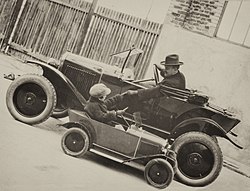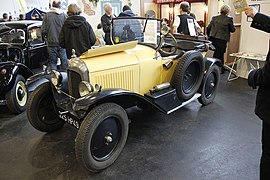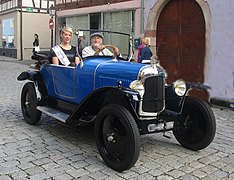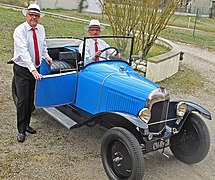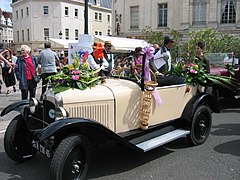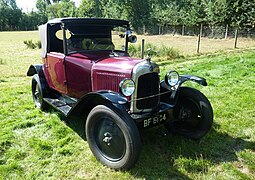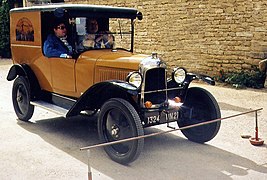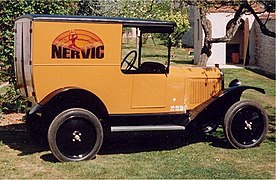Citroën type C.
| Citroën | |
|---|---|
|
5HP Torpedo T2 & Citroënette
|
|
| Type c | |
| Production period: | 1922-1926 |
| Class : | Small car |
| Body versions : | Torpedo, convertible, delivery van |
| Engines: |
Otto engine : 0.86 liters (8.1 kW) |
| Length: | 3200 mm |
| Width: | 1400 mm |
| Height: | 1550 mm |
| Wheelbase : | 2230-2330 mm |
| Empty weight : | 540-590 kg |
The Citroën Type C was a small car designed by Edmond Moyet, of which the French manufacturer Citroën produced almost 83,000 units between 1922 and 1926. In France as Citroën 5 HP or 5 CV and in the UK known as 7.5 HP, it was the second model developed by André Citroën was marketed. It was also the first mass-produced car to follow the 10 HP Type A (June 1919), which was replaced by the 10 HP B2 (June 1921); they were the first European production cars. The first color it came in was yellow (a light “grapefruit yellow”), which earned it the nickname “petit citron” (little lemon). The nicknames "Cul de poule" (chicken poop) or "Boat tail-Citroën" refer to the tapering rear of the body and "Trefle" (clover leaf) to the shape of the three-seater version.
history
The French government encouraged automakers to invest in cycle cars through tax breaks . André Citroën, on the other hand, saw a market for larger vehicles. The 5 HP was Citroën's first small car, preceded by the slightly larger Type A. Despite its similarity to the Type A designed by Jules Salomon , the 5 HP was the work of engineer Edmond Moyet, who a few months earlier had made a very similar vehicle for Amilcar , the "CC". André Citroën's genius was to introduce this car to a female audience, which was very unusual at the time. All 5-HP advertising material represented the car driven by a young woman. With the 5 HP, Citroën connected itself to mass mobility. This is underlined by the fact that the 5 HP could also be bought in installments thanks to a consumer credit company founded by André Citroën, a method that was new at the time. After a slow start in 1922, the success was so great that the Type C accounted for almost half of Citroën's sales from 1924 and became one of the first European people's cars.
In 1922 the sales price of the 5 HP “Torpedo” (8,500 FR ) was around 60% of the sales price of the 10 HP (13,900 FR). The original trade name 5 HP became 5 CV in 1925 because the tax classification changed from HP ( Horse Power ) to CV (Cheval Vapeur).
A network of 5,000 agents was set up between 1919 and 1925. Exclusive subsidiaries and distributors were located all over the world: Great Britain, Italy , Japan , Spain , Belgium , North Africa , Australia , South America etc. From 1925, factories were built in Spain, Italy, Poland , Algeria , Belgium and England to handle customs duties on imported goods Avoid products (for example: Mac Kenna taxes in England). The "Torpedo" introduced in May 1922 had two seats and from 1923 was also available in a more luxurious "Cabriolet" version. In 1924 a three-seat version of the “Torpedo” was introduced, first with a “folding seat”, then with two seats in the front and one in the back, nicknamed the “clover”.
The Opel 4 PS is a plagiarism of the Type C. Allegations of intellectual theft were rejected with reference to the different radiator grilles . The visible difference was the color: Citroën only delivered the Type C in yellow, Opel only in green. A Citroën from 1922 and an Opel from 1927 can be found in the Aspang Automobile Museum in Aspang-Markt in Lower Austria for comparison.
The Citroën 5 HP was a role model in terms of reliability and economy compared to the models of the competition; it was extremely robust, as the voyage of Bubsy, a "used" torpedo with two students on board, should show: It circled Australia in 1925, drove 17,000 km in 5 months without any engine problems. The 5 HP was a success, but not sufficiently profitable. In order to prepare for the introduction of the “all-steel” -B 14, André Citroën decided - contrary to popular opinion - to stop production in May 1926. A C4 variant (5 HP) "all steel" was planned, but was abandoned because of the high costs. Today the 5 HP is the typical old-timer of the 1920s. It owes its success to the fact that it was already an immense commercial success in its time and that it is very easy to rebuild from historical and replica parts. Of the 83,000 5HP built, many have been converted into utility vehicles , tractors , etc. It is estimated that around 3000 (4%) specimens exist to date.
technology
The little Citroën was ahead of the competition: It was equipped with a differential and an electric starter, so that the car was advertised as particularly suitable for women who were sensitive to driving comfort. The weight of 543 kg essentially corresponds to that of the engine, the transmission and the rear axle. The maximum speed was 60 km / h with a fuel consumption of 5 l / 100 km.
The 5 HP chassis were manufactured in the factory in Levallois (a suburb of Paris), the cars were assembled in the factory in Javel ; Right-hand drive versions were available for the French market (there was still demand) and for export (England, Commonwealth, Sweden , Argentina and Australia). The body consisted of a wooden frame structure to which the body panels were nailed. It was the last Citroën with a body in this composite construction. The car had only one door, on the passenger side it opened to the front. The hinges were invisible (except on the convertible ) and the vibrations were dampened by a double-cone lock that prevented the doors from opening accidentally. Pre-production vehicles had a bonnet with three ventilation slots, and 16 ventilation slots were quickly introduced into series production.
In 1922, for technical reasons, the cooler was divided into a cooling element and a nickel-plated outer housing. The first Citroën badge on the radiator was initially blue chevrons on a nickel-plated base; later the colors were reversed. The four-cylinder engine with 856 cm³ displacement had a bore of 55 mm and a stroke of 90 mm, developed 8.2 kW (11 hp) and had thermosiphon cooling (water cooling with natural circulation).
From June 1, 1925, the cooling system in all models was improved by a fan (previously only installed in the Cabriolet). There was a Solex carburetor (Zenith on the VL model). The battery ignition was replaced by a magneto ignition in March 1923 . The transmission had three unsynchronized gears plus one reverse gear. The straight teeth of the gears in 1st and 2nd gear tended to "sing" and became loud when the gears or the bearings of the main and countershafts were worn. Their excessive play caused the shafts to be misaligned with each other, causing the gears to wear only at the ends of the teeth, causing additional noise and premature wear. In 3rd gear, the entrance and exit were directly coupled.
As with other cars of the time, the gas pedal was located centrally between the clutch and the brake. The front wheels were unbraked, the foot pedal operated the external shoe brake on the gearbox and a handbrake lever operated the brakes on the rear wheels. The brakes weren't the strong point of this car; It was necessary to foresee and balance the effect of the two braking systems, also at the risk of breaking a drive shaft in the rear axle. Many 5 HP were modified to couple the transmission brake and rear brakes, and this modification eventually went into production on the last of the 1926 models.
The ladder frame made of longitudinal beams with a C-profile was designed trapezoidally and reinforced by cross beams. The rigid axles were suspended from four quarter- elliptical leaf springs. From 1925 onwards, friction dampers were installed on the rear axle of the heavier “Cabriolet”. At the end of 1923 the short type C2 chassis was lengthened by 10 cm from 2.25 m to 2.35 m and reinforced with an additional cross member that supported the rear of the body. This resulted in the long wheelbase type C3 chassis. With the extended frame, the new three-seater version of the “Torpedo” and the “Voiture de Livraison” (delivery van) were offered. The extension can be recognized by the longer distance between the spare wheel and the rear fender. This chassis was manufactured without changes until the end of production. The rear axle was of the " banjo " type with a round or oblong (oval) shape. The teeth of the gears on the rear axle were herringbone . An oblique cut, easier to produce and more robust, became available as a spare part from 1928. In the beginning there were Michelin high-pressure tires with a beaded rim ("Cablé" tires) in the size 700x80, which were inflated to 4 to 5 bar, which led to poor road holding and poor comfort. They were replaced in June 1924 by 715x115 Michelin "Cablé Confort" ( balloon tires ) with low air pressure (2.5 bar), which were initially offered as optional equipment and then fitted to all cars from June. 11-12x45 with clincher tires on rims appeared in 1927 with "Confort Bibendum" tires with low pressure (1.5 to 1.75 bar) and were fitted as a replacement for the original bead rims.
Since the equipment level of the 5 CV was relatively simple, many component suppliers took the opportunity to offer several solutions to improve driving comfort or driving performance, such as luggage rack , fuel gauge (OS), water thermometer (Boyer meter), speedometer and clock ( Jaeger, OS), shock absorbers ( Houdaille , Repusseau), front brakes (Poulet, Acmos), engine improvements (Super-Culasse Desprez, Transformations F. Crespelle, Ruby-Ricardo cylinder head).
Models
Source In the years 1922-23, the "Torpedo" (Tourer) T2 and the "Cabriolet" (Cabriolet) TL were two-seater versions on the chassis with a short wheelbase (C2). The extension of the chassis (C3) enabled the production of a long wheelbase version of the “Torpedo” T2 and the “Cabriolet” TL, the “Voiture de Livraison” VL, a light commercial vehicle, and the three-seater version “Torpedo”, initially with a third foldable seat, T3-1 "a strapontin", which was replaced in October 1924 by another three-seat version T3-2 "Trefle" (clover leaf), which offered space for a single passenger in the rear.
Torpédo two-seater T2
Production: Short wheelbase chassis C2: May 1922 to September 1923, then long wheelbase C3 chassis: October 1923 to spring 1925. Source The original (C2-1922 / 23) body color was yellow; With the introduction of the long chassis (C3-1924 / 25), other colors became available: Bordeaux red, blue or Havana (brown). The comfortable bench was initially covered with synthetic leather (C2): black, then (C3): red, black (for blue cars) or brown. The flooring was brush carpet. There were storage compartments in the door and next to the driver. The spare wheel was mounted on the driver's side. Door hinges were not visible. In the rear of the car there was a small trunk that was accessible from above and closed with a lid. In addition to the trunk lid, two supports could be attached, on which a suitcase with the dimensions 40x80 cm fit. The running boards were made of aluminum and reinforced with long beads . They were painted black, the top of the beads was polished bright. The fenders and the body were made of black painted sheet metal. The black painted headlights with nickel-plated decorative rings were connected by an adjustable nickel-plated crossbar. The polished and machined aluminum dashboard was simple, with just an ammeter and a combined headlamp and ignition switch. The windshield was in two parts: the lower third was fixed, the rest could be opened around a pivot point in the upper third of the frame. The convertible top could be opened around a single axis and was covered with waterproof fabric. All weather equipment (side curtains) was available. The “flat fenders” (“ailes plates”) were replaced by “round fenders” (“ailes rondes”) for the 1926 model: very few such cars were produced.
Torpedo three-seater a Strapontin (with "folding seat") T3-1
Production: Chassis with long wheelbase C3: October 1923 to the end of 1924. Source The body, which is based on the 2-seater “Torpedo” but has a rounded tail, was enlarged to create more space than the Torpedo T2. The spare wheel was mounted on the driver's side. The trunk was behind the driver's seat. It was accessible from above and closed with a lid. The driver's seat was permanently installed. The passenger seat, mounted on two cylindrical rails, could be moved back and forth. At the front, under the dashboard, was a foldable jump seat that could be fitted when the front passenger seat was in the rear position. Body colors: Bordeaux red, blue or Havana. A small number were painted green (moss green). Seats and interior: artificial leather red, black (for blue cars) or brown. The flooring was black brushed carpet. There were storage compartments in the door and next to the driver. This model was only made in limited numbers (only 8000) because customers did not like the inconvenience of the folding seat. This model has since been incorrectly referred to by collectors as the “Faux Trefle” (false clover leaf).
Torpedo three-seater Trefle (clover leaf) T3-2
Production: Long-wheelbase chassis C3: early 1925 to June 1926. Source This model replaced T3-1. Its door has been enlarged by 12 cm compared to the models T2 and T3-1. There were two individual seats in the front, the third seat was in the middle at the back, hence the nickname "Torpedo Trefle" (clover leaf). A passage between the front seats gave access to the rear seat. There were two small compartments to the right and left of the rear seat. They were accessible from above and closed with a lid. The body color was dark beige until December 1924, when it became burgundy, cannon blue or Havana. Seats and interior in synthetic leather: red or black for red cars; black for blue cars; brown or black for cars from Havana. The flooring was black brushed carpet. There were storage compartments in the door and next to the driver. The spare wheel was attached to the rear.
Cabriolet (convertible) TL
Production: Chassis with short wheelbase (C2): March 1923 to September 1923, then chassis with long wheelbase (C3): October 1923 to June 1926. Source The “Cabriolet” was more luxurious and comfortable than the “Torpedo”, that was the rear same. Body color: yellow or Havana (C2-mid 1923), then (C3-mid 1923/26): Bordeaux red, cannon blue or Havana. Seats and interior: synthetic leather: red or black for red cars; black for blue cars; brown or black for cars from Havana. The flooring was black brushed carpet. The roof was hermetically sealed; it was made of black synthetic leather, with a fabric lining and metal brackets. The roof could be opened and closed from the inside. For chassis with a long wheelbase, the roof was available in red, brown or black synthetic leather. There were storage compartments in the door and next to the driver. The trunk lid of the short-wheelbase chassis was larger than that of the T2 model, which made it impossible to attach the external luggage rack; Because customers had complained, the smaller cover was used again for the long wheelbase chassis. Inside, behind the seats, was a small hatch closed with a lid that gave access to the trunk. A T-shaped door handle was attached to the outside. The hinges are visible. A comfortable bench offered enough space for two people. On the first models, the passenger seat was a little narrower to make it easier to access. On the short wheelbase chassis, the dashboard is made of polished, machined aluminum; on the long wheelbase chassis, it was replaced with mahogany, which was painted with inlaid cabinet friezes on the dashboard and inlays on the moldings under the windows. The two side windows could be pushed down and were operated with a belt, as with the railroad cars of that time. These windows could remain latched in the high position even with the top down. The windshield was in two parts, the upper part opened to the front to allow more fresh air and some visibility in heavy rain.
Voiture de Livraison (delivery van) VL
Production: Long chassis (C3): early 1924 to mid-1925. Source The vehicle's payload was 125 kg. The internal dimensions of the cargo space are 750 mm long, 1,070 mm wide and 1,070 mm high. The car had two separate seats, synthetic leather. The driver's seat was firmly mounted and the passenger cushion could be removed. The roof is one-piece and consists of a wooden frame covered with wire mesh, felt and moleskin or synthetic leather.
Storage compartments were installed in the door and next to the driver. The dashboard was made of black painted sheet metal. The handrails were made of aluminum and painted black. The windshield was in two parts, the upper part opened to the front like the convertible. The usable space in the rear was equipped with two swing doors. In the front partition wall of the passenger cell there was a sliding door that made it possible to accommodate loads with a length of 1500 mm. The vehicle had only one door, either to the right or left, which opened to the front. There were curtains made of waterproof canvas on either side . Body color: Havana; Seats: black synthetic leather. The floor was covered with rubber.
swell
- John Reynolds: André Citroën - The man and the motor car. John Reynolds . Sutton Publishing, 1996, ISBN 0-905778-32-4 .
- Bernard Laurent, C itroën 5HP , Editions Bernard Laurent, Fevrier 2006 ( online ).
- Bozi Mohacek ( online ).
- Willy Schafroth: Citroën 5HP ( fr, en, de ) Accessed September 4, 2019 ..
- Paul Blank: The First Car Around Australia . Retrieved September 4, 2019 ..
- First Car Round Australia onYouTube.
Web links
- Information and lots of pictures about the Citroën Type C.
- Website for the Citroën 5 HP (including history, model description, documentation)
Individual evidence
- ↑ Citroën 5HP par Bernard Laurent ( fr )
- ^ First Car Around Australia . Retrieved December 4, 2018.
- ↑ chassis . Retrieved April 25, 2020.
- ↑ Bernard Laurent: Citroen 5HP , p Chassis Models 29 to 47th
- ↑ Torpedo T2 . Retrieved April 25, 2020.
- ↑ Torpedo T3-1 . Retrieved April 25, 2020.
- ↑ Torpedo T3-2 . Retrieved April 25, 2020.
- ↑ Cabriolet TL .
- ↑ Voiture de Livraison VL .
